

 |
Search the Site with

|
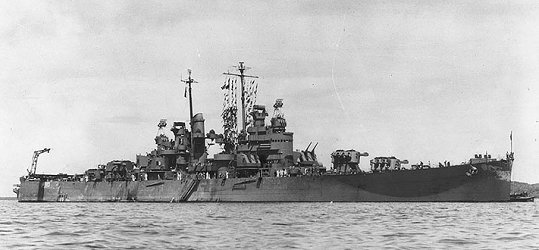 | Sorry, no coat of arms available. |
USS DENVER was the fourth ship in the CLEVELAND - class of light cruisers and the second ship in the Navy named after the city in Colorado. Decommissioned at the Philadelphia Navy Yard in February 1947, the DENVER was part of the Atlantic Reserve Fleet until March 1959, when she was stricken from the Navy list. The ship was sold for scrapping in February 1960.
| General Characteristics: | Awarded: 1940 |
| Keel laid: December 26, 1940 | |
| Launched: April 4, 1942 | |
| Commissioned: October 15, 1942 | |
| Decommissioned: February 7, 1947 | |
| Builder: New York Shipbuilding, Camden NJ. | |
| Propulsion system: geared turbines, 100,000 shp | |
| Propellers: four | |
| Length: 610.2 feet (186 meters) | |
| Beam: 66.3 feet (20.2 meters) | |
| Draft: 24.6 feet (7.5 meters) | |
| Displacement: approx. 14,130 tons fully loaded | |
| Speed: 32.5 knots | |
| Aircraft: four | |
| Armament: twelve 15.2cm 6-inch/47 caliber guns in four triple mounts, twelve 12.7cm 5-inch/38 caliber guns in six twin mounts, 24 40mm guns, 17 20mm guns | |
| Crew: 70 officers and 1285 enlisted |
Crew List:
This section contains the names of sailors who served aboard USS DENVER. It is no official listing but contains the names of sailors who submitted their information.
USS DENVER Cruise Books:
USS DENVER History:
USS DENVER was launched 4 April 1942 by New York Shipbuilding Corp., Camden, N.J.; sponsored by Miss L. J. Stapleton, daughter of the Mayor of Denver; and commissioned 15 October 1942, Captain R. B. Carney in command.
DENVER sailed from Philadelphia 23 January 1943, and arrived at Efate, New Hebrides, 14 February. The new cruiser first saw combat in the bombardment of Vila, Solomon Islands, on 6 March. During this action her force engaged and sank two Japanese destroyers, MINEGUMO and MURASAME. Continuing her operations in the Solomons, DENVER joined the bombardment of Ballale Island on 29 and 30 June in conjunction with the invasion landings on New Georgia, then remained in the area on patrol.
On the last day of October 1943 DENVER sortied from Port Purvis with TF 39 to intercept an enemy force attempting to disrupt the landings at Cape Torokina, Bougainville. In the resulting Battle of Empress Augusta Bay on the night of 1-2 November, the American ships sank one enemy light cruiser and a destroyer and damaged two heavy cruisers and two destroyers, while the four other enemy ships broke off the action and retired. During the heavy firing DENVER was hit by three 8-inch shells which fortunately did not explode. She shared in the Navy Unit Commendation awarded to her division for its outstanding performance in this battle.
DENVER covered the support landings on Cape Torokina on 10 and 11 November 1943, and 2 days later during a heavy air attack was hit by an aerial torpedo which knocked out all power and communications and killed 20 of her men. She was towed by SIOUX (AT 75) to Port Purvis and by PAWNEE (AT 74) to Espiritu Santo for temporary repairs, then sailed to Mare Island for permanent repairs, arriving 2 January 1944.
DENVER returned to the forward area at Eniwetok, arriving 22 June 1944. Eight days later she put to sea to screen carriers as they launched strikes to neutralize Japanese bases in the Bonins and Marianas during the invasion of the Marianas. She bombarded Iwo Jima 4 July, and after screening continued air assaults returned to Eniwetok 5 August.
DENVER sailed from Port Purvis 6 September 1944 for the invasion of the Palaus. She bombarded Angaur Island from 12 to 18 September, then covered a task unit engaged in minesweepmg, reconnaissance and underwater demolition operations before the landings on Ulithi 23 September. She returned to Manus 28 September to prepare for the return to the Philippines.
DENVER departed 12 October 1944 for the landings on Leyte, bombarding Suluan Island and Dulag to open the vast invasion fleet's way into Leyte Gulf, then sailed on to bombard the southern landing beaches. As the Japanese sent the major portion of their remaining combatant fleet south in a desperate attempt to break up the landings, DENVER's group took station in Surigao Strait on 24 October to prevent the passage of the Japanese Southern Force into Leyte Gulf. Gallant attacks were made by motor torpedo boats and destroyers stationed in advance of the battle line, and battleship YAMASHIRO, heavy cruiser MOGAMI, and destroyer SHIGURE were all that remained of the Japanese ships when DENVER and the others of the battle line opened fire at 0351. With three other cruisers, she made a material contribution to the cumulative gunfire which sank YAMASHIRO. MOGAMI was later sunk by aircraft, and SHIGURE was the sole survivor of the mighty fleet which had sailed forth for this phase of the decisive Battle for Leyte Gulf. After this action, DENVER sailed to aid in polishing off enemy cripples, aiding in sinking destroyer ASAGUMO early in the day on 25 October.
Continuing her service in Leyte Gulf, she fought off numerous attacks; during the one of 28 October a bomb released from one of the planes she shot down exploded nearby causing minor damage and slight flooding. She screened reinforcement landings in November and fought off a suicide attack on 27 November, suffering four men wounded from fragments of a bomb which exploded 200 yards off the starboard quarter. She joined the heavy covering group, for the Mindoro landings of 13 to 16 December, then returned to Manus 24 December.
Returning to San Pedro Bay 3 January 1945 DENVER sortied the next day to cover the landings at Lingayen Gulf. She remained in the Philippines to join in the consolidation of those islands. She covered the landings on Zambales on 29 and 30 January, supported minesweeping near and landings on Grande Island; provided fire support at Nasugbu on 31 January; escorted a replenishment convoy to Mindoro between 1 and 7 February; covered the Army landings around Mariveles Bay from 13 to 16 February, rescuing the survivors of mined LA VALLETTE (DD 448); and supported the operations on Palawan and Mindanao Islands from February to May.
On 7 June 1945 DENVER sailed from Subic Bay for the amphibious assaults on Brunei Bay, Borneo, and later at Balikpapan. She covered the preinvasion work of minesweeping units and underwater demolition teams, and provided fire support for the invading troops until returning to San Pedro Bay, Leyte, 4 July for brief overhaul.
DENVER got underway for Okinawa 13 July 1945 to hunt Japanese shipping off the China coast until 7 August. She sailed from Okinawa 9 September to cover the evacuation of men of the Allied forces rescued from prison camps in the Wakayama area and covered the landing of occupation troops at Wakanoura Wan from 25 September to 20 October, when she sailed for home.
DENVER arrived at Norfolk 21 November 1945 and after overhaul, reported to Newport, R.I., in January 1946 for duty training men of the Naval Reserve, and a good-will visit to Quebec, Canada. In April she arrived at Philadelphia Naval Shipyard where she was placed out of commission in reserve 7 February 1947. She was sold 29 February 1960.
In addition to the Navy Unit Commendation DENVER received 11 battle stars for World War II service.
USS DENVER Image Gallery:
 | 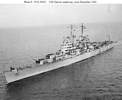 | 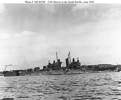 | 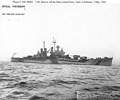 | 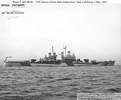 |
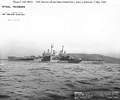 | 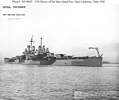 |  | 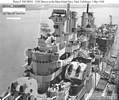 |  |
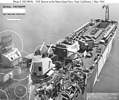 |
 Back to Light Cruisers list.
Back to Light Cruisers list.  Back to Ships list.
Back to Ships list.  Back to selection page.
Back to selection page.  Back to 1st page.
Back to 1st page.